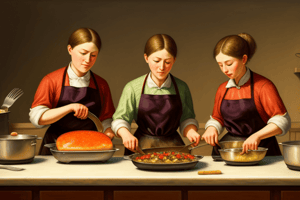Podcast
Questions and Answers
What is the typical proportion of cooking liquid used in braising and stewing?
What is the typical proportion of cooking liquid used in braising and stewing?
- 2/3 to 3/4 of the cooking vessel
- 1/3 to 1/2 of the cooking vessel
- 1/2 to 2/3 of the cooking vessel (correct)
- 3/4 to full capacity of the cooking vessel
What is the primary purpose of browning in braising and stewing?
What is the primary purpose of browning in braising and stewing?
- To add moisture to the dish
- To enhance flavor development (correct)
- To remove excess fat from the meat
- To reduce cooking time
Which cooking method is NOT suitable for braising and stewing?
Which cooking method is NOT suitable for braising and stewing?
- Slow cooker
- Grilling (correct)
- Oven braising
- Stovetop braising
What is the primary factor that contributes to meat tenderization in braising and stewing?
What is the primary factor that contributes to meat tenderization in braising and stewing?
Which of the following is NOT a factor that enhances flavor in braising and stewing?
Which of the following is NOT a factor that enhances flavor in braising and stewing?
What is the result of reducing cooking liquids in braising and stewing?
What is the result of reducing cooking liquids in braising and stewing?
Flashcards are hidden until you start studying
Study Notes
Cooking Liquids
- Braising and stewing use liquid to cook the food, typically 1/2 to 2/3 of the cooking vessel
- Common cooking liquids:
- Stock (beef, chicken, or veal)
- Wine (red, white, or fortified)
- Water
- Broth
- Cream or milk
- Juice (e.g., tomato or citrus)
Browning
- Browning is essential for flavor development in braising and stewing
- Two types of browning:
- Dry browning (searing): quickly cooking the food in a hot pan to create a crust
- Moist browning: cooking the food in a small amount of oil or fat to create a rich, caramelized crust
Slow Cooking
- Braising and stewing require low heat and long cooking times to break down connective tissue in meat
- Cooking methods:
- Oven braising: cooking in a covered vessel in the oven
- Stovetop braising: cooking on the stovetop in a covered vessel
- Slow cooker: cooking in a specialized electric appliance
- Cooking times:
- 2-3 hours for smaller cuts of meat
- 4-6 hours for larger cuts of meat
Meat Tenderization
- Braising and stewing break down collagen in connective tissue, making meat tender and fall-apart
- Factors affecting tenderization:
- Cooking time and temperature
- Acidic ingredients (e.g., tomatoes or wine)
- Enzymatic reactions (e.g., papain in papaya)
Flavor Enhancement
- Braising and stewing allow for the development of complex flavors through:
- Caramelization of sugars
- Maillard reaction (browning reaction)
- Reduction of cooking liquids to intensify flavors
- Addition of aromatics (e.g., onions, carrots, and celery)
- Use of spices and herbs to add depth and character
Cooking Liquids
- Braising and stewing use liquid to cook food, covering 1/2 to 2/3 of the cooking vessel.
- Common cooking liquids include stock, wine, water, broth, cream or milk, and juice.
Browning
- Browning is crucial for flavor development in braising and stewing.
- There are two types of browning: dry browning (searing) and moist browning.
- Dry browning creates a crust by quickly cooking food in a hot pan.
- Moist browning creates a rich, caramelized crust by cooking food in a small amount of oil or fat.
Slow Cooking
- Braising and stewing require low heat and long cooking times to break down connective tissue in meat.
- Cooking methods include oven braising, stovetop braising, and slow cooker.
- Cooking times vary depending on the size of the meat cuts, with smaller cuts taking 2-3 hours and larger cuts taking 4-6 hours.
Meat Tenderization
- Braising and stewing break down collagen in connective tissue, making meat tender and fall-apart.
- Factors affecting tenderization include cooking time and temperature, acidic ingredients, and enzymatic reactions.
Flavor Enhancement
- Braising and stewing allow for complex flavor development through caramelization of sugars, Maillard reaction, and reduction of cooking liquids.
- Aromatics such as onions, carrots, and celery can be added to enhance flavor.
- Spices and herbs can be used to add depth and character to the dish.
Studying That Suits You
Use AI to generate personalized quizzes and flashcards to suit your learning preferences.





